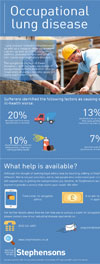The HSE’s Occupational Lung Disease in Great Britain 2017 report says mesothelioma as well as a range of other respiratory cancers as well as chronic obstructive pulmonary disease, occupational asthma, pneumoconiosis and other non-cancerous respiratory diseases occur as a result of work related activities.
The symptoms of most of these diseases – with the main exception of occupational asthma and other allergic respiratory disease – become apparent many years after exposure.
The HSE’s labour force survey says that the numbers affected are:
- 12,000 lung disease deaths each year estimated to be linked to past exposures at work
- 18,000 estimated annual new cases of self-reported breathing or lung problems caused or made worse by work
Trends in mortality in this area are difficult to assess but self-reported work-related breathing or lung problems for those working in the last 12 months have stayed largely the same level for ten years.
 |
What factors are causing or making ill-health worse?
Suffers identified the following factors as causing or making their ill-health worse:
- Dusts from stone, cement, brick or concrete (nearly 20% of cases)
- Airborne materials from spray painting or manufacturing foam products (in 13% of cases)
- Dusts from flour, grain/cereal, animal feed or straw (7% of cases)
- Airborne materials while welding, soldering, or cutting/grinding metals” (10% of cases)
There are no figures in this particular report for age, region or sex differences. With such a large number of people blaming breathing or lung problems on work, it is important to know the symptoms.
What are the symptoms of occupational lung disease?
If you’re worried about any unusual symptoms, please seek medical advice at the earliest opportunity. When attending medical appointments, we always recommend that you discuss your job history with clinicians. This can help ensure you receive the appropriate investigations and treatment.
Public Health England's ‘Be Clear on Cancer’ campaign advises that if a person is experiencing any of the following symptoms for more than three weeks, they are strongly advised to go to their GP;
- A cough that doesn’t go away
- A worsening of a long standing cough
- Unexplained breathlessness
- Chest infections
- Coughing up blood
- Unexplained weight loss
- Chest and/or shoulder pains
- Unexplained tiredness or lack of energy
- Hoarse voice
Stephensons believe it is also vital that at the same time, you get legal advice from a solicitor with specialist experience of dealing with industrial disease claims. This is because the law only provides a three year window in which to try and settle a claim and then issue court proceedings. Known as the ‘limitation period’, the courts do have a discretion to extend it but this is not always possible, so the sooner you obtain specialist advice on a potential claim, the better. Contact our specialist industrial disease solicitors on 01616 966 229.



Comments